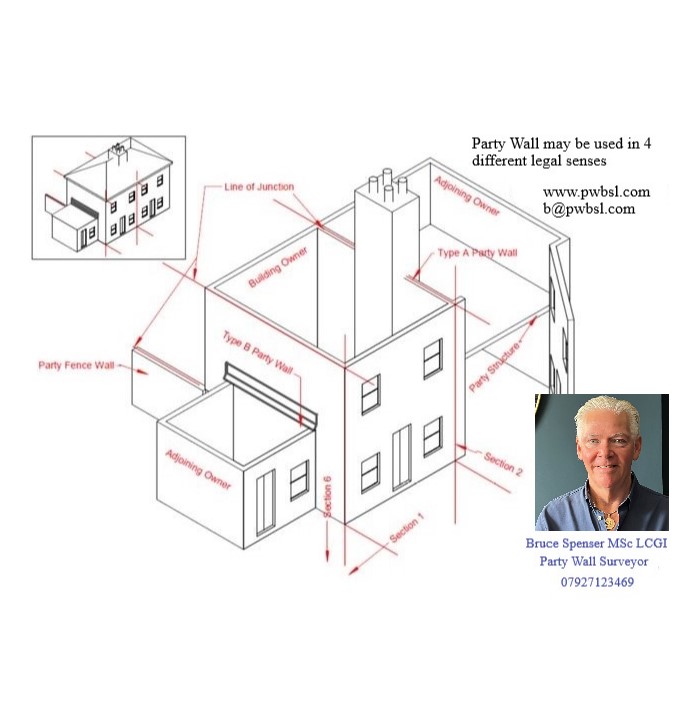Type B Party Wall
The Party Wall Act can not be used to legalise trespass – The Type B Party Wall
A building is a structure with roof and walls; A Building is owned by an owner. A part B party wall separates two buildings owned by different owners but does not stand on the land of both owners, it stands on the land of one owner. In order to separate the two buildings the type b party wall must be owned by one owner and the other owner has legal rights to enclose upon the wall; ie The wall must have been originally built to separate the two buildings or been legally enclosed upon by an adjoining owner ie by payment utilising the party wall act, legal purchase, legal agreement. If the adjoining owner has no legal rights to use the wall and they have enclosed upon it they are trespassing (slyly usurping); The wall does not separate two buildings, it is the external wall of one building which is being enclosed upon by a 3 walled structure with a roof – London Building Act 1939 allows such a 3 walled structure with a roof to be enclosed vertically downwards from the edge of its roof – “Provided that where a building on one or more of its sides is not enclosed by a wall or walls the building where unenclosed shall be deemed to be enclosed by walls with the external surface thereof in a vertical plane extending downwards from the outer edge of the roof”
- Frederick Betts Ltd v Pickfords Ltd [1906] – Chancery Division. London Building Act 1894 – The expression Party wall means; a. a wall forming part of a building and used or constructed to be used for separation of adjoining buildings belonging to different owners or occupied or constructed or adapted to be occupied by different persons – this is the current type b party wall; The adjoining owner had enclosed on the building owner’s wall; Kekewich J; “what right had the defendants to use that wall as a party wall? It is the external wall built by the plaintiffs on their own ground. If the defendants desire to use the adjoining premises for stables or for any other purpose they can erect their own containing wall; they have no business to use the wall of the plaintiffs, and it seems to me that they doing that,, and that there again they are using as a party wall what they have no business to use as a party wall.” The courts granted an injunction restraining the adjoining owner from committing any trespass on the wall or from using the walls as party walls. The adjoining owners were ordered to remove the stanchions and roof timbers.
:A common mistake made by Party Wall Surveyors is to determine that the Building Owner’s wall, which has been enclosed upon in the following circumstances, is a Type B Party Wall:
- No award is in place to allow the enclosure
- No legal documents are in place to allow the enclosure
- No legal documents are in place to allow the trespasser to be an owner as per the act – an owner as per the act needs to own the wall, if they don’t own the wall they can not be an owner under section 20 of the act – see below.
- The Party Wall Act suspends common law (Roadrunner – LJ Chadwick [2004])
- The Land Registration Act 2002 removed, “squatter’s rights” and Adverse possession and the adjoining owner has not applied to be registered as proprietor in place of the registered proprietor
- Weston v Arnold [1873] – Weston did not contest that the enclosed wall was a party wall but contested rights to light above the enclosure
- Watson v Grey [1880] – a Trespass represents an outster of rights and can be removed by the complainant.
- London Building Act 1930 – “area” in relation to a building means the superficies of a horizontal section thereof made at the point of its greatest surface inclusive of the external walls and of such portions of the party walls as belong to the building
- London Building Act 1930 – “external wall” means an outer wall or vertical enclosure of any building not being a party wall
- London Building Act 1930 – “party wall” means a wall forming part of a building and used or constructed to be used for separation of adjoining building belonging to different owners or occupied or constructed or adapted to be occupied by different persons
- London Building Act 1939 – “party wall” means— (i) a wall which forms part of a building and stands on lands of different owners to a greater extent than the projection of any artificially formed support on which the wall rests; and (ii) so much of a wall not being a wall referred to in the foregoing paragraph (i) as separates buildings belonging to different owners;
- London Building Act 1939 – “cubical extent” in relation to the measurement of a building means the space contained within the external surfaces of its walls and roof and the upper surface of the floor of its lowest storey but excluding any space within any enclosure on the roof of the building used exclusively for accommodating a water tank or lift gear or any like apparatus: Provided that where a building on one or more of its sides is not enclosed by a wall or walls the building where unenclosed shall be deemed to be enclosed by walls with the external surface thereof in a vertical plane extending downwards from the outer edge of the roof;
Section 20 of the Act – Interpretation
A type B party Wall is a wall which stands entirely upon the land of one owner and has been enclosed upon – see Betts v Pickford – the enclosure has to be legal
“party wall” means—
(a)a wall which forms part of a building and stands on lands of different owners to a greater extent than the projection of any artificially formed support on which the wall rests; and
(b)so much of a wall not being a wall referred to in paragraph (a) above as separates buildings belonging to different owners

Party Wall Surveyor serving Thanet and London
Third Surveyor serving England and Wales


